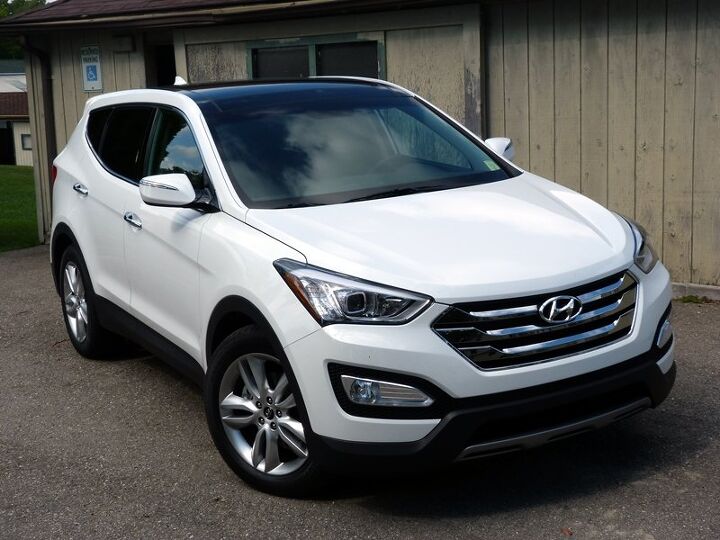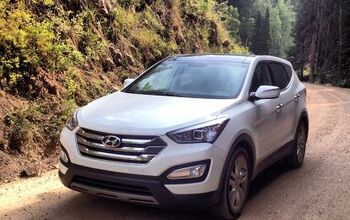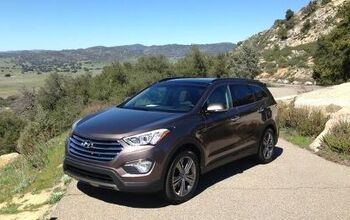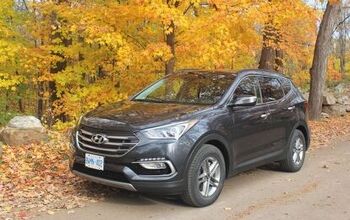Review: 2013 Hyundai Santa Fe Sport
On paper, there’s no contest. For the same price as the new Ford Escape, the even newer Hyundai Santa Fe Sport includes a longer warranty, more power, and a much roomier interior. But if such comparisons could be decided from the spec sheets alone, auto reviewers would have to find a new line of work.
You might have noticed some similarities between Hyundai’s and Ford’s most recent designs. Both follow a “more is more” philosophy in their rush to offer the look of 2025 today. With the Santa Fe Sport, oversized facial features and an undersized greenhouse collaborate to visually pump up overhangs already a half-foot longer than the Escape’s (on a nearly identical wheelbase). For those seeking less roided proportions (or two more seats), the Santa Fe Sport will soon be joined by a three-row Santa Fe (sans Sport).
Inside, the Santa Fe Sport has the cleaner, more restrained design of the two, such things being especially relative in this case. There’s plenty of visual sci fi in the center stack, but it doesn’t intrude as deeply into the passenger compartment. Nor is the instrument panel as deep are as tall, contributing to a more open view forward. Hyundai keeps upgrading its materials. The new Santa Fe Sport’s are better than those in the Sonata, if not quite a match for those in the Azera. If Ford has an edge here, it’s a slender one.
The Santa Fe Sport isn’t roomier than the Escape only through its interior design. It simply contains more space inside, about 3.5 more inches for both shoulders and legs. For a family of five people tall enough to see out of the Hyundai’s rear side windows, the choice between the two would be easy. Despite the Hyundai’s plumper posterior, the two are more evenly matched in terms of cargo volume (if the official specs are roughly comparable, which they often aren’t).
Hyundai is rightly proud of the over three hundred pounds the crossover lost with this redesign. The Santa Fe Sport might be considerably larger than the Ford Escape, but it’s no heavier. With 2.0T engines and all-wheel-drive, both weigh a little over 3,700 pounds. Drop the turbo and all-wheel-drive from the SFS, and the 190-horsepower 2.4-liter four-cylinder engine has so little trouble motivating 3,459 pounds that the boosted uplevel engine seems unnecessary…until you drive it, then the 264-horsepower 2.0T’s much stouter (if less even) midrange becomes readily evident. Despite being down 24 horsepower and hitched to a less decisive six-speed automatic transmission, the Escape’s engine feels even more energetic and more responsive.
Turbocharged four-cylinder engines allegedly have a significant fuel economy advantage over V6s. If I had written this review a few weeks ago, I’d have relayed EPA ratings of 20 city and 27 highway for the Santa Fe Sport 2.0T AWD. But, as you might have heard, “procedural errors” in Hyundai’s testing led it to report inflated fuel economy figures. Because the miscalculation involved aerodynamic drag, the subsequent adjustment has had the largest impact on crossovers’ highway ratings. The SFS’s numbers have been shaved from 20/27 to a far less competitive 19/24. The antiquated, 350-pound-heavier, V6-powered 2012 Santa Fe managed 20/26. Suddenly the economy benefits of boost aren’t so apparent. The Escape 2.0T AWD checks in at 21/28.
Science experiment: which most affects handling, size or curb weight? This comparison between equally hefty vehicles suggests size. The Santa Fe Sport might weigh about the same as the Escape, but it feels much bulkier. Not that the Hyundai handles badly. Body motions over wavy pavement and roll in turns are both much better controlled than in the previous Santa Fe. As in the Escape (though here only with AWD), torque vectoring via selective application of the brakes limits understeer. You can even select from three different levels of steering assist. Unfortunately, the three levels are light, lighter, and lightest and all of them are equally numb. The more tightly and precisely suspended Escape has its own dynamic flaws (a crossover-high CoG tends to make some key tradeoffs insurmountable), but it does more than handle curves competently. It makes them fun. In comparison, the Santa Fe Sport isn’t sporty.
When I say the two crossovers are the same price, I’m not employing any procedural missteps to massage the numbers. Equip a 2013 Ford Escape SEL with the 2.0T engine, AWD, leather upholstery, panoramic sunroof, and nav, and the window sticker reads $35,625. Do the same with the 2013 Hyundai Santa Fe Sport and the sticker reads…$35,625. TrueDelta’s car price comparison tool gives the Ford a slight ($190) edge in content, so they remain very close even after adjusting for feature differences. Okay, maybe I’m eliding one minor matter. To get 19-inch rims on an Escape you must spend a few hundred more for the Titanium. But adjust for the extra features that attend the higher trim level and it actually ends up a slightly better value.
“Value” might seem out of place in a comparison between mainstream brand compact crossovers with window stickers in the mid-thirties. (I’m having a hard time coming to grips with this myself.) But the Ford provides much of the driving enjoyment of a BMW X3 for about $10,000 less. On paper, the Santa Fe Sport should perform at least as well, but subjectively it’s a different animal. That fierce face is only skin deep. In how it drives, the Santa Fe Sport aims for the heart of the market, more athletic than a Chevrolet, Honda, or Toyota but unlikely to elicit comparisons to BMWs. The Hyundai’s value appeal is similarly conventional: same price, more car. More fun or more inches, what’s your preference?
Both cars were provided with fuel and insurance by their manufacturers. Hyundai also provided lunch.
Michael Karesh operates TrueDelta.com, an online source of car reliability and pricing information.
Michael Karesh lives in West Bloomfield, Michigan, with his wife and three children. In 2003 he received a Ph.D. from the University of Chicago. While in Chicago he worked at the National Opinion Research Center, a leader in the field of survey research. For his doctoral thesis, he spent a year-and-a-half inside an automaker studying how and how well it understood consumers when developing new products. While pursuing the degree he taught consumer behavior and product development at Oakland University. Since 1999, he has contributed auto reviews to Epinions, where he is currently one of two people in charge of the autos section. Since earning the degree he has continued to care for his children (school, gymnastics, tae-kwan-do...) and write reviews for Epinions and, more recently, The Truth About Cars while developing TrueDelta, a vehicle reliability and price comparison site.
More by Michael Karesh
Latest Car Reviews
Read moreLatest Product Reviews
Read moreRecent Comments
- Kmars2009 I rented one last fall while visiting Ohio. Not a bad car...but not a great car either. I think it needs a new version. But CUVs are King... unfortunately!
- Ajla Remember when Cadillac introduced an entirely new V8 and proceeded to install it in only 800 cars before cancelling everything?
- Bouzouki Cadillac (aka GM!!) made so many mistakes over the past 40 years, right up to today, one could make a MBA course of it. Others have alluded to them, there is not enough room for me to recite them in a flowing, cohesive manner.Cadillac today is literally a tarted-up Chevrolet. They are nice cars, and the "aura" of the Cadillac name still works on several (mostly female) consumers who are not car enthusiasts.The CT4 and CT5 offer superlative ride and handling, and even performance--but, it is wrapped in sheet metal that (at least I think) looks awful, with (still) sub-par interiors. They are niche cars. They are the last gasp of the Alpha platform--which I have been told by people close to it, was meant to be a Pontiac "BMW 3-series". The bankruptcy killed Pontiac, but the Alpha had been mostly engineered, so it was "Cadillac-ized" with the new "edgy" CTS styling.Most Cadillacs sold are crossovers. The most profitable "Cadillac" is the Escalade (note that GM never jack up the name on THAT!).The question posed here is rather irrelevant. NO ONE has "a blank check", because GM (any company or corporation) does not have bottomless resources.Better styling, and superlative "performance" (by that, I mean being among the best in noise, harshness, handling, performance, reliablity, quality) would cost a lot of money.Post-bankruptcy GM actually tried. No one here mentioned GM's effort to do just that: the "Omega" platform, aka CT6.The (horribly misnamed) CT6 was actually a credible Mercedes/Lexus competitor. I'm sure it cost GM a fortune to develop (the platform was unique, not shared with any other car. The top-of-the-line ORIGINAL Blackwing V8 was also unique, expensive, and ultimately...very few were sold. All of this is a LOT of money).I used to know the sales numbers, and my sense was the CT6 sold about HALF the units GM projected. More importantly, it sold about half to two thirds the volume of the S-Class (which cost a lot more in 201x)Many of your fixed cost are predicated on volume. One way to improve your business case (if the right people want to get the Green Light) is to inflate your projected volumes. This lowers the unit cost for seats, mufflers, control arms, etc, and makes the vehicle more profitable--on paper.Suppliers tool up to make the number of parts the carmaker projects. However, if the volume is less than expected, the automaker has to make up the difference.So, unfortunately, not only was the CT6 an expensive car to build, but Cadillac's weak "brand equity" limited how much GM could charge (and these were still pricey cars in 2016-18, a "base" car was ).Other than the name, the "Omega" could have marked the starting point for Cadillac to once again be the standard of the world. Other than the awful name (Fleetwood, Elegante, Paramount, even ParAMOUR would be better), and offering the basest car with a FOUR cylinder turbo on the base car (incredibly moronic!), it was very good car and a CREDIBLE Mercedes S-Class/Lexus LS400 alternative. While I cannot know if the novel aluminum body was worth the cost (very expensive and complex to build), the bragging rights were legit--a LARGE car that was lighter, but had good body rigidity. No surprise, the interior was not the best, but the gap with the big boys was as close as GM has done in the luxury sphere.Mary Barra decided that profits today and tomorrow were more important than gambling on profits in 2025 and later. Having sunk a TON of money, and even done a mid-cycle enhancement, complete with the new Blackwing engine (which copied BMW with the twin turbos nestled in the "V"!), in fall 2018 GM announced it was discontinuing the car, and closing the assembly plant it was built in. (And so you know, building different platforms on the same line is very challenging and considerably less efficient in terms of capital and labor costs than the same platform, or better yet, the same model).So now, GM is anticipating that, as the car market "goes electric" (if you can call it that--more like the Federal Government and EU and even China PUSHING electric cars), they can make electric Cadillacs that are "prestige". The Cadillac Celestique is the opening salvo--$340,000. We will see how it works out.
- Lynn Joiner Lynn JoinerJust put 2,000 miles on a Chevy Malibu rental from Budget, touring around AZ, UT, CO for a month. Ran fine, no problems at all, little 1.7L 4-cylinder just sipped fuel, and the trunk held our large suitcases easily. Yeah, I hated looking up at all the huge FWD trucks blowing by, but the Malibu easily kept up on the 80 mph Interstate in Utah. I expect a new one would be about a third the cost of the big guys. It won't tow your horse trailer, but it'll get you to the store. Why kill it?
- Lynn Joiner Just put 2,000 miles on a Chevy Malibu rental from Budget, touring around AZ, UT, CO for a month. Ran fine, no problems at all, little 1.7L 4-cylinder just sipped fuel, and the trunk held our large suitcases easily. Yeah, I hated looking up at all the huge FWD trucks blowing by, but the Malibu easily kept up on the 80 mph Interstate in Utah. I expect a new one would be about a third the cost of the big guys. It won't tow your horse trailer, but it'll get you to the store. Why kill it?














































Comments
Join the conversation
"The color options are very limited. You essentially can only pick this car in black, white, or silver. The other colors range from garish to fugly." The maroon is pretty astounding, as well as the brown. Not too shabby of a choice.... I too am disappointed with the panoramic roof set-up. I need a luggage rack. Oddly, you can get one with the panoramic roof on the Kia twin. Style over substance. It'll be interesting to see how the RAV-4 and Forester come to market, although they are a half-size smaller.
I like the front & rear appearance of the SFS...even the side view...oh, wait...until the eye follows that radically-pinched greenhouse to the D-pillar, as in Murano, Rogue, Traverse. A belt line which follows the contour of the prominent body-side crease would have been an elegant & visually balanced solution. With this type of restricted visibility, it's amazing that a backup camera isn't standard equipment!